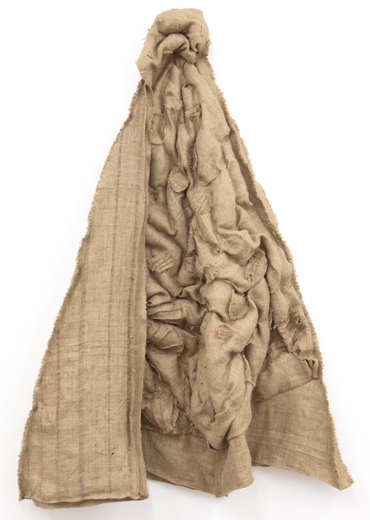- HANNES BEND: ECLIPSE

- LAURA A. OGDEN’S SWAMPLIFE: PEOPLE, GATORS, AND MANGROVES ENTANGLED IN THE EVERGLADES
CHRISTY GAST: OUT OF PLACE
Amanda Sanfilippo

Christy Gast, “Out of Place.” Installation view. Photo courtesy of Gallery Diet.
Some of the works in Out of Place form archetypal shapes such as “Lee” (2012), an oval fold of the rough-hewn material leaning into natural curves and stitched pleats. Others are more akin to shamanistic Beuysian assemblages of semi-recognizable objects, such as “Walkabout” (2012), a cowboy hat rigged to a series of ropes and pulleys, the hat snaking off the wall and sitting quizzically upon the floor. “Redland” (2012) is the only piece that betrays its objecthood, a reconstructed burlap feed sack with the word “CORN” and details of a label carefully reverse-stitched into the material. It is not only Beuys’s insistence on materiality and symbolic associations for the inherent qualities of such which are recalled by Gast’s employ of burlap, but also a recognition that the objects — their representation here — are imbued with powers.

Christy Gast, “Estero,” 2012. Photo courtesy of Gallery Diet.
While previously engaging in the fundamentals of a site through the creation of situations — a practice defined by Claire Doherty as when a particular site, time, and space converge to destabilize notions of place — Gast is more involved here in an act of transmogrification. Though defined by the limits of their own making, the works collapse physical distance by strongly evoking a site/non-site dialectic. Yet, the relationship between site and object is disrupted. Entrenched in a fetishization of site, the new works worry over signs and signifiers for places both essential and irrelevant to their creation. Whether placeholders, totems or wisps of memory, the works in Out of Place are a clean slate on which to consider the reality of an object/place vs. the idea of such.









